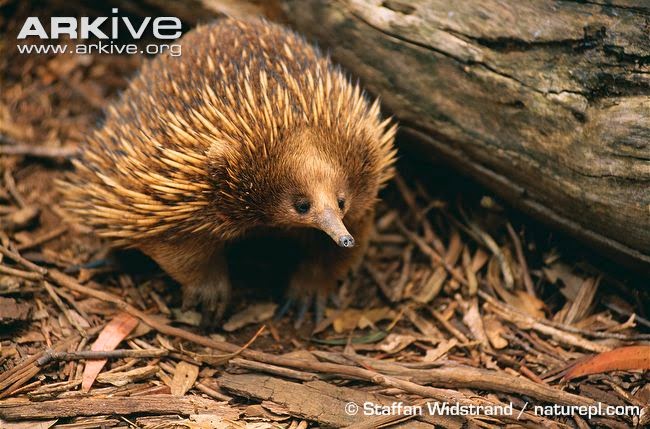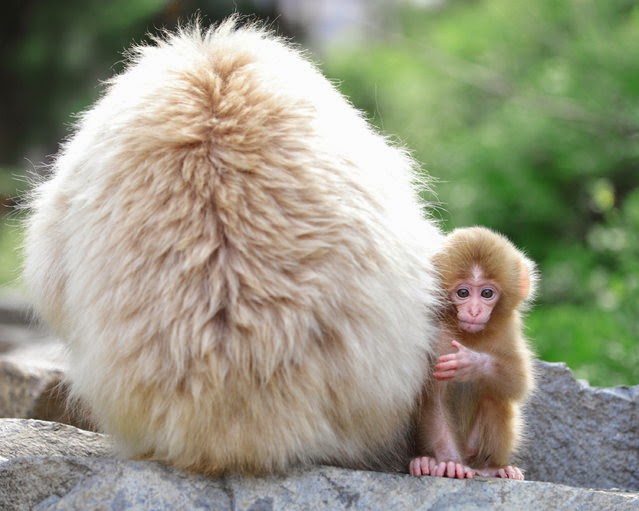Nursing Patterns & Mothers Milk
Among many mammals, lactating females may have extended periods of time in between nursing bouts. This is often the case for females who “cache” or “park” their young in nests, dens, or burrows while they depart to forage more efficiently unencumbered by the presence of the young (parents, you know what I am talking about).
The egg-laying echidna is an excellent, if totally weird, example.
After hatching from the egg inside the mother’s pouch, the young—known as a puggle—consumes milk secreted from a patch on the mother’s tummy. Once the puggle is too large for the pouch, lactating echidnas dig nursery burrows. Here the young waits to nurse 3 to 6 DAYS between mother’s visits (1). Maternal foraging trips and inter-nursing intervals have also been well-studied in other species, particularly in seals (2) and rabbits (3). These inter-nursing intervals lead to "high-fat" milk (aka energetically dense) (4, 5). A comparison among prosimian primates showed that indeed the species that “parked” their young had higher fat concentrations than did closely related species that carried young while foraging (6).
However, among most primate species, mothers carry young with them throughout the day as they forage, socialize and even occasionally when the mother is locomoting. Infants have what is known as “on demand” nipple access, especially in the early infancy period.
I heart rhesus.
Sustained access to the mother is not just during the daytime, if anything it increases at night when primate mothers and infants co-sleep (7). Among humans, co-sleeping and night-time breastfeeding characterize much of the world’s diverse cultures and most likely throughout our evolutionary history (8–10). Nighttime nursing, especially in the context of safe co-sleeping arrangements, is implicated in sustaining lactation and achieving breastfeeding goals for mothers (8).
The “behavioral biology” of milk production—greater demand generates greater output- is one way by which night-time breastfeeding may sustain lactation and help mothers meet their breastfeeding goals. Co-sleeping can facilitate more frequent nursing and evacuation of the mammary gland. This high through-put, on demand nursing pattern is known to increase lactose synthesis, pull more water into the mammary gland and increase milk yield (11). In this way, infant demand can increase milk production in the mother, insofar as mothers behaviorally give in to that demand (12, 13).
But mothers don’t always give in—I have watched monkey mothers lay down on the ground to prevent the infant from gaining nipple access. Human mothers typically attempt to distract or pacify babies with play or an object when they are disinclined to nurse at the moment of infant demand.
photo by Kiyoshi Ookawa
SIDEBAR: Importantly keep in mind that there is a very complex dynamic between "QUANTITY" of milk aka volume and "QUALITY" of milk aka caloric density- but let's tackle that in a future post.
The best understanding of the milk demand à production dynamic emerges from animal science research in dairy cows. Increasing frequency of milking improves milk production, and increasing milking frequency often involves night milking. In an elegant inter-mammary, within cow design, researchers showed that milking four times a day (every six hours) produced higher yields than did twice daily milking (every 12 hours) (14). This increased milk production continued even after the frequency of milkings was reduced to twice daily, revealing that milk “demand” in early lactation increased milk production throughout lactation (14). The persistent changes in mammary gland gene expression underlying this effect have been reported recently (15).
But night-milking is not just about increasing milk production; the composition of milk collected at night differs from day milk. Of particular interest to our purposes here are hormones that are implicated in sleep cycles, such as melatonin. Concentrations of melatonin in milk can be up to ten times higher when cows are milked at night compared with daytime (16). And when that night milk was fed to rats, their circulating melatonin increased AND had improved sleep (as assessed via concentrations of a sleep-associated metabolite urinary sulfatoxymelatonin) (16).
SQUEEEEEEEE!!!!!
But that’s in rats, what about in humans?
Consumption of melatonin-rich milk, collected via night milking of dairy cows, increased daytime activity of some, but not all, elderly patients in rest homes, without altering their nighttime sleep patterns (19). These studies suggest that there are potential applications for improving human health through strategic night milking of dairy animals.
Night Milking by Himba woman in Namibia
photo by Jakob Holdt
But for breastfeeding mothers, this also means that night milk may have importantly different features from daytime milk for babies. There are hundreds of bioactive hormones in milk that likely vary across the 24 hours of the day. What they do when consumed by the infant remains poorly explored if not TOTALLY UNKNOWN (17, 18). Clearly, and as per usual, we need MOAR RESEARCH.
In April, hypotheses about infant nighttime crying appeared in the media, I wrote an open access commentary about some considerations of that in the journal Evolution, Medicine, and Public Health.
References:
1. Rismiller PD, McKelvey MW (2009). Activity and behaviour of lactating echidnas (Tachyglossus aculeatus multiaculeatus) from hatching of egg to weaning of young. Australian J Zool 57: 265–273.
2. Arnould JPY, Boyd IL, Socha DG (1996). Milk consumption and growth efficiency in Antarctic fur seal (Arctocephalus gazella) pups. Can J Zool 74: 254–266.
3. Rödel HG, Dausmann KH, Starkloff A, Schubert M, von Holst D, Hudson R. (2012). Diurnal nursing pattern of wild-type European rabbits under natural breeding conditions. Mamm Bio 77: 441–446.
4. Ben Shaul DM (1963). The composition of the milk of wild animals. Int Zoo Yearbook 4: 333–342.
5. Oftedal OT (1984). Milk composition, milk yield and energy output at peak lactation: a comparative review. In: Peaker M, Vernon RG, Knight CH, editors. Physiological strategies in lactation: the proceedings of a symposium held at the Zoological Society of London on 11 and 12 November 1982.
6. Tilden CD, Oftedal OT (1997). Milk composition reflects pattern of maternal care in prosimian primates. Am J Primatol 41: 195–211.
7. Konner M (2010). The Evolution of Childhood: Relationships, Emotion, Mind. Harvard University Press.
8. McKenna JJ, Ball HL, Gettler LT (2007). Mother–infant cosleeping, breastfeeding and sudden infant death syndrome: what biological anthropology has discovered about normal infant sleep and pediatric sleep medicine. Am J Phys Anthropol 134(S45): 133–161.
9. McKenna JJ (2014). Night waking among breastfeeding mothers and infants: Conflict, congruence or both? Evol Med Public Health, 2014 (1): 40–47.
10. Worthman CM (2011). Developmental cultural ecology of sleep. In: El-Sheikh M, editor. Sleep and development: familial and socio-cultural considerations. New York: Oxford University Press. pp. 16–194.
11. Akers RM (2002). Lactation and the Mammary Gland. Wiley-Blackwell.
12. Lincoln DW (1983). Physiological mechanisms governing the transfer of milk from mother to young. In: Rosenblum L, editor. Symbiosis in parent-offspring interactions. New York: Springer. pp. 77–112).
13. Miller EM, Aiello, MO, Fujita M, Hinde K, Milligan L, Quinn EA (2013). Field and laboratory methods in human milk research. Am J Hum Biol 25: 1–11.
14. Hillerton JE, Knight CH, Turvey A, Wheatley SD, Wilde CJ (1990). Milk yield and mammary function in dairy cows milked four times daily. J Dairy Res 57: 285–294.
15. Wall EH, Bond JP, McFadden TB (2013). Milk yield responses to changes in milking frequency during early lactation are associated with coordinated and persistent changes in mammary gene expression. BMC Genomics 14: 296.
16. Milagres MP, Minim VP, Minim LA, Simiqueli AA, Moraes LE, Martino HS (2014). Night milking adds value to cow's milk. J Sci Food Agric 94: 1688–1692.
17. Valtonen M, Niskanen L, Kangas AP, Koskinen T (2005). Effect of melatonin-rich night-time milk on sleep and activity in elderly institutionalized subjects. Nord J psychiatry, 59: 217–221.
18. Neville MC, Anderson SM, McManaman JL, Badger TM, Bunik M, Contractor N, et al (2012). Lactation and neonatal nutrition: defining and refining the critical questions. J Mammary Gland Biol Neoplasia 17: 167–188.
19. Savino F, Liguori SA, Fissore MF, Oggero R (2009). Breast milk hormones and their protective effect on obesity. Int J Pediatr Endocrinol 2009: 327505.







Comments
Post a Comment